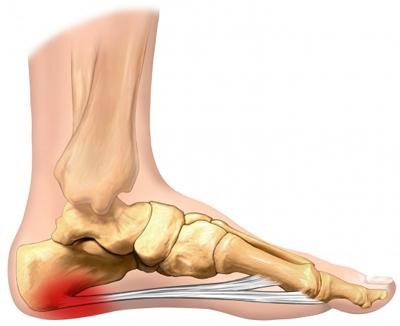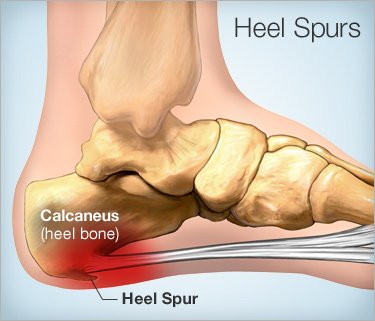HEEL PAIN
Podiatrist, Foot & Ankle Surgeon serving Miami and Hialeah, FL area
Plantar Fasciitis
Plantar fasciitis is one of the most common orthopedic conditions relating to the foot. It is when the thick tissue on the bottom of the foot (the plantar fascia) becomes inflamed and irritated, making it difficult to walk. This is most often the result of repeated episodes of minor but recurring injury, such as with frequent running or long periods of standing. The pain can be located in the heel area of the foot or in the arch. It is often worse in the morning due to stiffness of the tissue, and also becomes worse after long periods of walking. The pain often decreases with rest.
Diagnosis - PerfectFeetCare Podiatry Center’s Podiatrist will exam your foot searching for:
Tenderness on the bottom of your foot
Flat feet or high arches
Mild foot swelling or redness
Stiffness or tightness of the arch in the bottom of your foot.
X-rays may be taken to rule out other problems.
Treatment - Treatment options for plantar fasciitis include
CLARIX FIO® - REGENERATIVE THERAPY - Injectable Therapy For Heel Pain(Plantar Fasciitis)
rest
stretching
night splints
physical therapy
cold therapy
heat therapy
anti-inflammatory medications
injection of corticosteroids
Also, in some cases, massaging of the inflamed location serves as a temporary relief.
Treatment can span several months to two years before symptoms improve. Most patients will see an improvement within one year. Further treatment may include steroid injections into the sole of the foot, or in certain situations a surgical procedure that releases the plantar
Without Treatment - Foot pain can continue, and progress into a severe condition that affects the ability to walk. Eventually, permanent damage to the plantar fascia.
Heel Spurs
A heel spur is a calcium deposit on the underside of the heel bone. On an X-ray, a heel spur protrusion can extend forward by as much as a half-inch. Without visible X-ray evidence, the condition is sometimes known as "heel spur syndrome." Although heel spurs are often painless, they can cause heel pain. They are frequently associated with plantar fasciitis, a painful inflammation of the fibrous band of connective tissue (plantar fascia) that runs along the bottom of the foot and connects the heel bone to the ball of the foot. Treatments for heel spurs and associated conditions include exercise, custom-made orthotics, anti-inflammatory medications, and cortisone injections. If conservative treatments fail, surgery may be necessary.
Diagnosis - heel spur can be seen on an X-ray as an extension of bone in front of the heel. Heel spurs often cause no symptoms. But heel spurs can be associated with intermittent or chronic pain - especially while walking, jogging, or running - if inflammation develops at the point of the spur formation. In general, the cause of the pain is not the heel spur itself but the soft-tissue injury associated with it. Many people describe the pain of heel spurs and plantar fasciitis as a knife or pin sticking into the bottom of their feet when they first stand up in the morning: a pain that later turns into a dull ache. They often complain that the sharp pain returns after they stand up after sitting for a prolonged period of time.
Heel Spur Treatments
Non-Surgical Treatments for Heel Spurs - The heel pain associated with heel spurs and plantar fasciitis may not respond well to rest. If you walk after a night's sleep, the pain may feel worse as the plantar fascia suddenly elongates, which stretches and pulls on the heel. The pain often decreases the more you walk. But you may feel a recurrence of pain after either prolonged rest or extensive walking.
If you have heel pain that persists for more than one month, consult PerfectFeetCare Podiatry Centers. Our Podiatrists may recommend conservative treatments such as:
Stretching exercises
Shoe recommendations
Taping or strapping to rest stressed muscles and tendons
Shoe inserts or orthotic devices
Physical therapy
Heel pain may respond to treatment with over-the-counter medications such as acetaminophen (Tylenol), ibuprofen (Advil), or naproxen (Aleve). In many cases, a functional orthotic device can correct the causes of heel and arch pain such as biomechanical imbalances. In some cases, injection with a corticosteroid may be done to relieve inflammation in the area.
Surgery for Heel Spurs - If conservative treatment fails to treat symptoms of heel spurs, surgery may be necessary to relieve pain and restore mobility. Surgical techniques include:
Release of the plantar fascia
Removal of a spur
In most cases, plantar fascia release (with or without heel spur removal) has proven effective. But pre-surgical tests or exams are required to identify optimal candidates, and it's important to observe post-surgical recommendations concerning rest, ice, compression, elevation of the foot, and when to place weight on the operated foot. In some cases, it may be necessary for patients to use bandages, splints, casts, surgical shoes, crutches, or canes after surgery. Possible complications of heel surgery include nerve pain, recurrent heel pain, permanent numbness of the area, infection, and scarring. In addition, with plantar fascia release, there is risk of instability, foot cramps, stress fracture, and tendinitis.
Without Treatment - The pain due to the plantar fasciitis that causes the heel spur can become progressively more severe, in some cases damaging the tissue.



